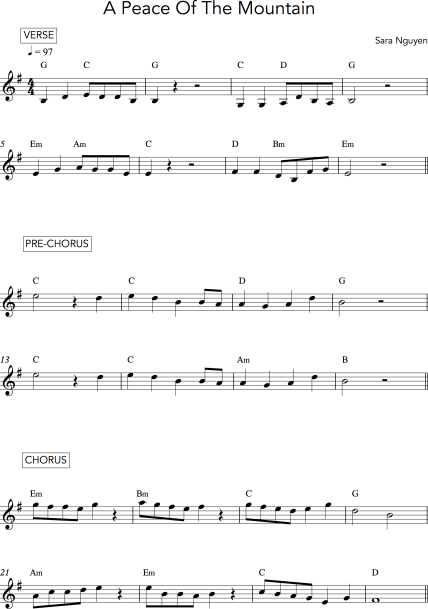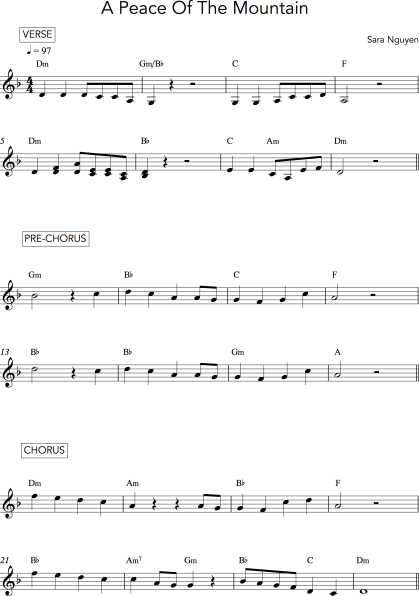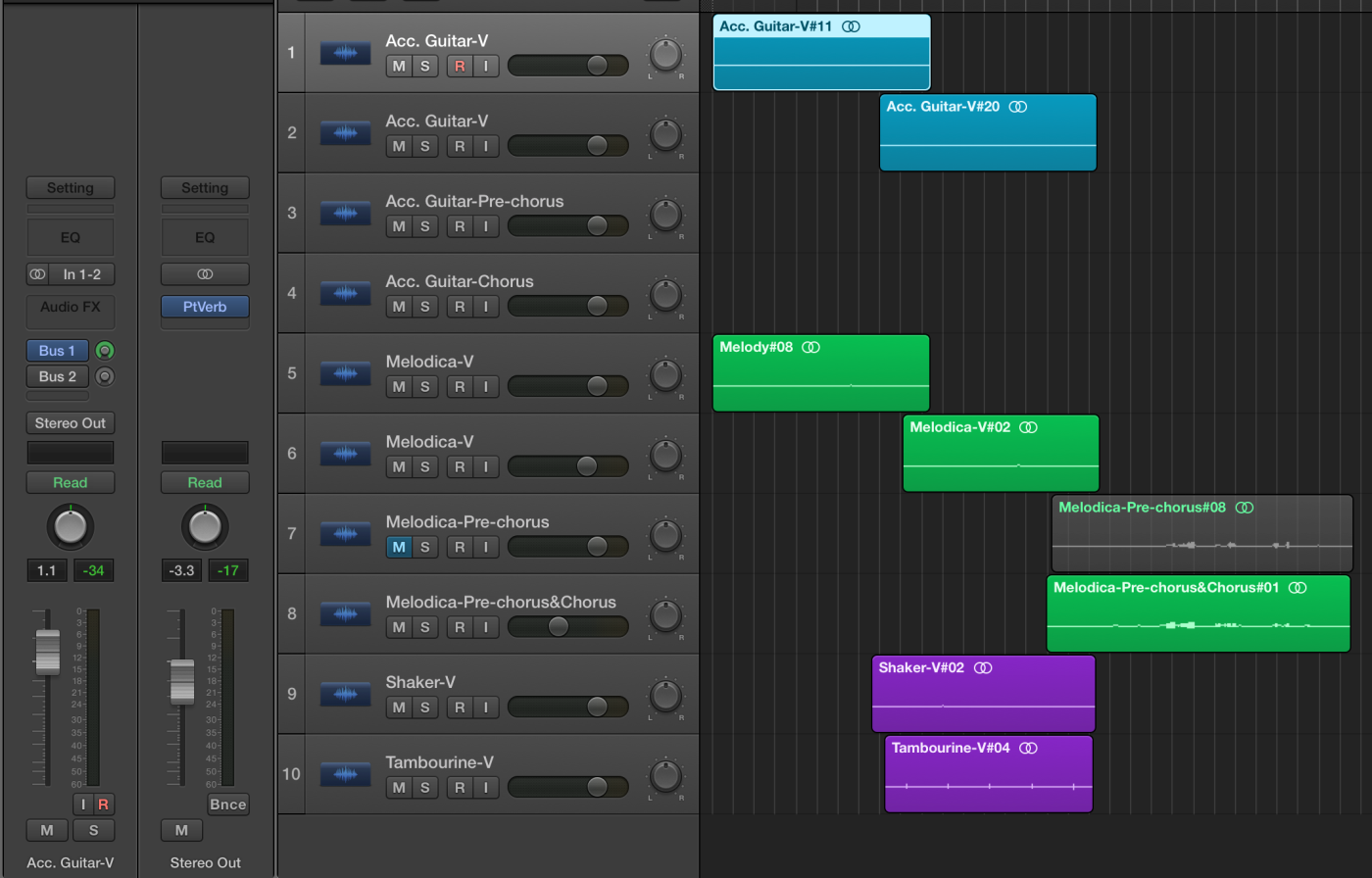Warning: Long blog!
For today’s entry, we will be looking at a smashing 4 ‘draft’ phases for A Peace Of The Mountain! Woo! As we progress through these 4 draft stages, you will begin to see what the composition process of ‘A Way of Composition’ looks like in finer detail, and for certain decisions, why I made the choices I made from a composer’s point of view.
1. Draft 3 – Changing chords & structure
From where I left off in Draft 2, I was content with the mood of the piece, being peaceful and joyous – drawing inspirations from Celtic Woman’s You Raise Me Up and Janice Kapp Perry’s How Many Hearts Have Been Turned. But the more I listened to Draft 2, I felt something was missing. I experimented with some various chord progressions and in particular after listening to You Raise Me Up and How Many Hearts Have Been Turned, I noticed that the composer had varied the timing of the chord changes for various sections. E.g. 2 chords to one bar – making the melody progress quicker with this instant chord changes.
This meant changing little parts of the melodies in the verse, and extending the Pre-Chorus section to have that additional chord change, ending with a B major chord.

I mentioned in my previous entry blog post – At this stage, I still wasn’t content with the register of the chorus tune – hearing that it might be impractically high were it for a vocalist singing it.
After listening to more examples of Irish repertoire, such as The Locket, The Wild Mountain Thyme – the *Aeolian mode was a common thread between many.
*Aeolian mode – Typically a natural minor scale (All white notes on the keyboard starting from A-A)
Notes in the A Aeolian mode:
A B C D E F G A
Particularly, D Aeolian is a common register and range to centre melodies around. This led me to lower the key of the piece from G major/E minor to F major/D minor.
Hence, another draft! Yay
2. Draft 4 – Changing keys

Because I am in a new key that’s lower than what I had originally, I was able to play around the tune for the Pre-chorus and Chorus and not be affected too much by the range of the high register.
At the end of this draft, I was able to concrete the rhythm and tune of the verse (with an extra harmony to the tune), but was still edgy towards the Pre-chorus and Chorus rhythm and tunes.
Thus another draft!
3. Draft 5 – Changing chords and tunes
Firstly, here I changed the chords of the Pre-chorus and Chorus which affected the entire melodic structure and pitch contouring,

Experimentation after experimentation, play after play, listen after listen, I can say that I am content with the current pitch contouring and shaping of the melodic structure of all sections. (With still some potential ornaments and embellishments which can still be added in for later).
4. Draft 6 – Adding and recording instruments
So FINALLY, after completing the Chords and Tunes of the piece, at draft 6 of the composition process, we’re now heading into what I believe is the best part of the compositional stage. ADDING INSTRUMENTS, PERFORMING AND RECORDING!
For this particular genre of music – folk song style with influences from Northern Ireland and South East Asia – simple instrumentation is the best option – especially since now I am aiming for something more peaceful, soulful, and reflective. I’ve chosen:
- Melodica for the tune (melody) – Reason for this particular instrument because its tone colour closely resembles that of the piano accordion used in Irish traditions, and also because it’s flexibility with a breathy sound of a wind instrument.
- Acoustic guitar to play chords (harmony) – I was close to choosing the piano instead, but due to the portable nature of the instrument and imagining being in a folk song traditional setting, the guitar is a more practical and suitable instrument to ‘set the mood’
- Cajon, shaker and tambourine (rhythm) for the same reasons as my choice for the acoustic guitar, simple and to ‘set the mood’.
I’m currently using Logic Pro X for recording, editing and production.

I’m a big believer in composition through improvisation and performance. And because I haven’t decided what to play on the acoustic guitar or cajon, accept only knowing something with arpeggios on the guitar and a simple beat pattern on the cajon, I decided to recorded the melody first (which isn’t something I usually do – I often record rhythm then melody – to keep time).

After recording the Melodica for the Verse, I liked the structure of having a solo Melodica introduction with simple accompaniment. Hence, I recorded another verse where the instruments would slowly enter.
Onto the Acoustic Guitar part, I improvised arpeggio lines under the melody and stuck to what sounded simple and flowing with the piece.

Finally, the Shaker and Tambourine are added in the second Verse though they have not been recorded for the Chorus yet. This is what Draft 6 looks like.

Now after recording, comes notation. (This step may vary according to each composer’s preferable composition process).
Let’s hear it!
Hear Draft 6 on my Soundcloud.
What Have I Done?
- After doing these 4 drafts, in a nutshell, I’ve basically cemented the first two stages of my compositional process of A Way To Composition, and that is my chords and tunes
- I’ve touched upon the early phases of stage 3 which is to extend instrumental layers – Acoustic Guitar, shaker, tambourine, and cajon (to be recorded in next draft), and possibly bass and strings?
- Added some reverb on the each instrument to give it depth and space
Reflection?
I am satisfied with the mood I’ve created for this piece, with the tone colours of my chosen instruments. The tune is peaceful, it’s predictable and unpredictable in different parts, and it FLOWS.
It was extremely fun experimenting with different chord patterns, progressions and tunes of these sections. At times, I would be so in to it, I’d forget what time it was and how long I was actually spending for this!
What Do I Do Now?
- Re-record some instrumental parts to make it in time E.g. Melodica part
- Notate the embellishments, ornaments and anacrusis’ that were recorded
- Add and record in the Cajon with a simple rhythmic pattern
- Notate string harmonic part for Violins and Cellos (Find potential players), and multitrack record
- Extend sections
- Clean up full score
Soli Deo Gloria.




October22, 2016 at 7:40 AM
Hi Sara,
I really like how you thought about the mood first and foremost – something that I had barely considered until I saw James for my 1-on-1 consultation (he said the genre of my composition was naturally laid-back). You’ve been very thorough about documenting the composition process (improvisation/playing before composing/notating) and your drafts really show how your composition has progressed. It sounds like you’re really getting into the flow of the process (the concept Rebecca mentioned yesterday in our TME lecture) and your piece sounds really professional, yet rustic/folk-like. Good stuff!
LikeLiked by 2 people
October22, 2016 at 8:01 AM
Thanks Gabby! I’m glad to hear that this compositional process is clear and flowing so far.
For me, mood is very important in any composition. It gives definition to a song and brings it alive. Hence for a laid out step-by-step compositional process, mood makes the steps come alive.
LikeLiked by 1 person